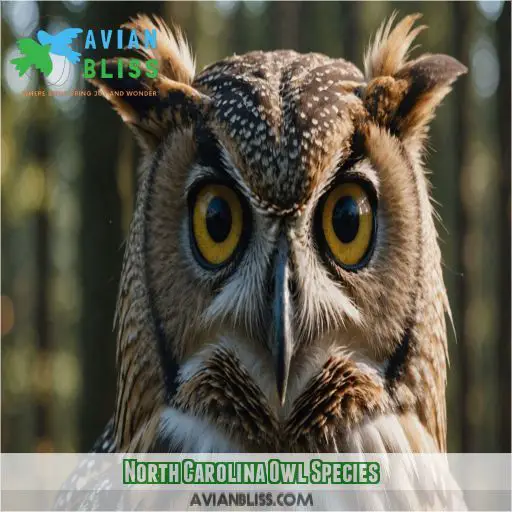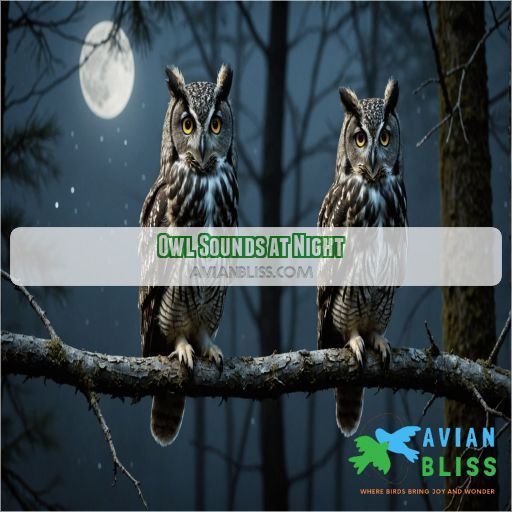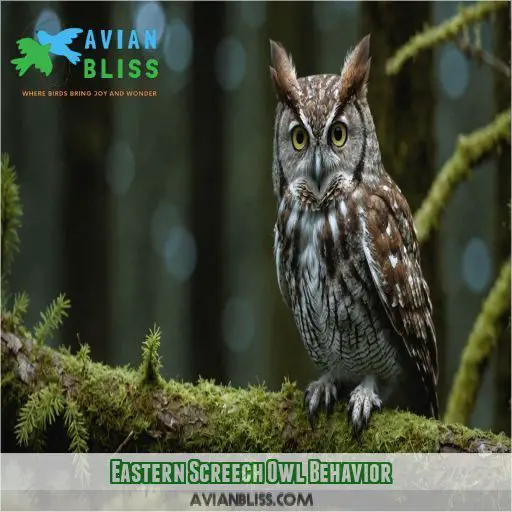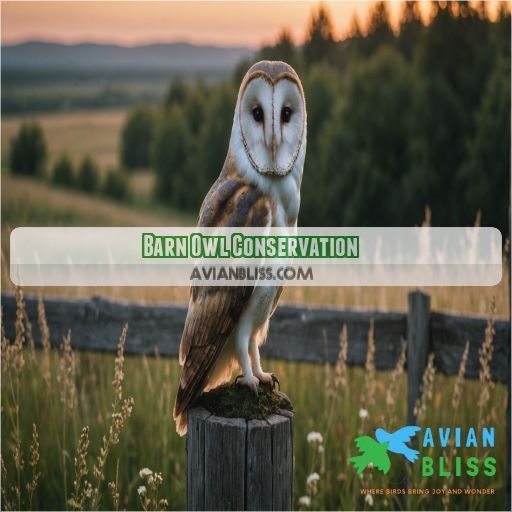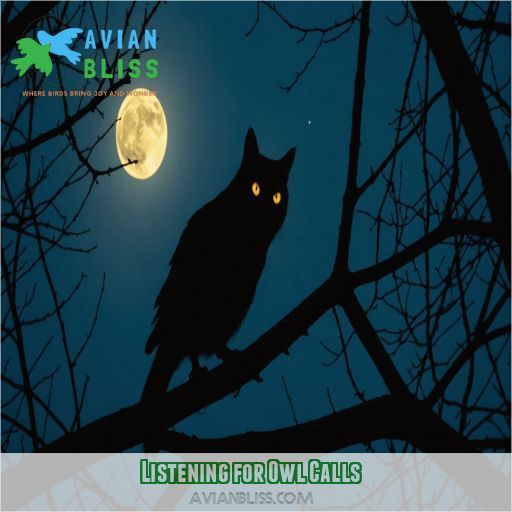This site is supported by our readers. We may earn a commission, at no cost to you, if you purchase through links.
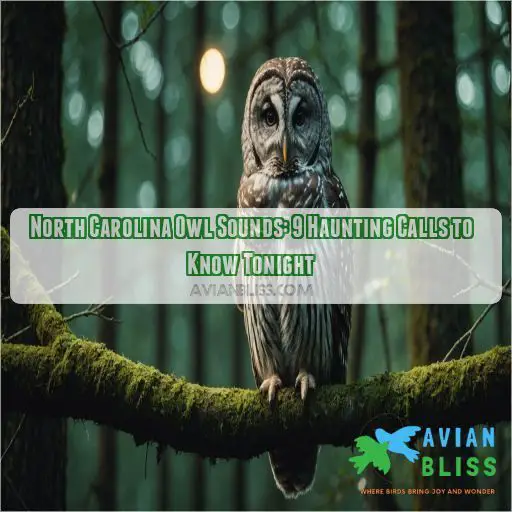
Imagine being in the woods at dusk, surrounded by the haunting calls of nine distinct owl species.
You’ll hear the Great Horned Owl‘s low, husky hoot, the Barred Owl‘s "Who-cooks-for-you?" call, and the Eastern Screech Owl‘s high-pitched whinny.
Each species has its unique voice, and by learning these calls, you’ll gain a deeper appreciation for these nocturnal birds.
As you explore the Tar Heel State’s owl sounds, you’ll discover the fascinating ways they communicate and claim their territory.
And that’s just the beginning.
Table Of Contents
- Key Takeaways
- North Carolina Owl Species
- Common Owl Calls in North Carolina
- Owl Sounds at Night
- Eastern Screech Owl Behavior
- Great Horned Owl Habitat
- Barred Owl Ecological Role
- Barn Owl Conservation
- Listening for Owl Calls
- Frequently Asked Questions (FAQs)
- Which owl makes a hoo hoo sound?
- What kind of owls does North Carolina have?
- What kind of owls scream at night?
- What bird sounds like an owl but isn’t an owl?
- What are the best months to hear owls in North Carolina?
- Can I hear owls during the day in North Carolina?
- How do I identify an owl by its call alone?
- Are all owl species in North Carolina migratory birds?
- Can I attract owls to my backyard in North Carolina?
- Conclusion
Key Takeaways
- You’re about to become an owl whisperer! By learning the unique calls of North Carolina’s Nocturnal Hunter Species, you’ll improve your chances of spotting these magnificent birds in the wild
, you’ll improve your chances of spotting these magnificent birds in the wild. You’ll also gain a deeper appreciation for their habitats and the important roles they play in the ecosystem.
- Don’t be surprised if you hear owls during the day! While they’re most active at night, some species, like the Barred Owl, vocalize during the day, especially when being mobbed by crows or smaller songbirds. So, keep your ears open, even when the sun is shining!
- Owls are masters of adaptability! You’ll find them thriving in urban environments, like cities and backyards, as well as in their natural habitats, like forests and woodlands. By understanding their adaptability, you can create a haven for these amazing birds in your own backyard.
- Get ready to join the conservation efforts! By learning about the challenges faced by North Carolina’s owl species, such as habitat loss and fragmentation, you can take action to protect these magnificent birds. From creating owl-friendly habitats to supporting conservation programs, every small step counts in safeguarding the future of these incredible creatures.
North Carolina Owl Species
You’re about to enter the enchanting world of North Carolina’s owl species, where nine distinct calls will transport you to a night of haunting beauty. Get ready to meet the fascinating residents of the Tar Heel State’s nocturnal landscape, including the Great Horned Owl, Barred Owl, Eastern Screech Owl, and Barn Owl, each with its unique characteristics and traits.
Great Horned Owl Description
Let’s explore the majestic world of Great Horned Owls in North Carolina.
Reaching lengths of 17 to 25 inches and weighing 2.64 to 3.52 pounds, these birds of prey rule the night sky.
Their diet consists of rabbits, rodents, birds, reptiles, amphibians, and insects.
Great Horned Owls can adapt to various habitats, including cities, but their populations have declined by 33% in North America over the past 50 years.
Barred Owl Characteristics
You’re in for a treat – the barred owl is a stunning bird with some remarkable characteristics. In North Carolina, you can spot these owls in mixed forests, where they feast on a diet rich in small mammals, birds, and reptiles. Here are three cool facts about Barred Owls:
- They’re known for their distinctive "Who-cooks-for-you?" call.
- They’re monogamous, with pairs forming during breeding season.
- They’re skilled nesters, often taking over abandoned nests from other birds.
Eastern Screech Owl Traits
You’re about to meet the Eastern Screech Owl, a master of adaptability!
This tiny owl, only 6-10 inches tall, has a big personality.
Its feathers can be gray or reddish-brown, helping it blend in with tree bark.
Its diet consists of insects, small rodents, and birds.
Listen for its distinctive whinnying call, a sure sign of its presence in North Carolina’s suburban neighborhoods.
Barn Owl Features
Get ready to meet the Barn Owl, a silent hunter with a taste for adventure! With a wingspan of up to 3.5 feet, these owls rule the night skies, swooping in on small mammals and insects with ease. Their facial disk helps pinpoint prey, and their silent flight means you won’t hear them coming – until you hear that bloodcurdling shriek!
Other Owl Species in North Carolina
You’re not alone in wondering what other owl species call North Carolina home. Beyond the Barn Owl, you might be surprised to discover:
- Northern Saw-whet Owls migrating through the state
- Short-eared Owls and Long-eared Owls making rare appearances
- Spotted Owls facing threats to their habitats
- Eastern Screech-Owls thriving in urban areas, thanks to conservation efforts.
Common Owl Calls in North Carolina
As you step into the enchanting world of North Carolina’s nocturnal birds, get ready to become familiar with the distinctive calls of the state’s owl species, like the Barred Owl’s hooting call.
, get ready to become familiar with the distinctive calls of the state’s owl species. You’ll learn to recognize the haunting sounds of the Great Horned Owl, Barred Owl, Eastern Screech Owl, and Barn Owl, making you a pro at identifying these birds in no time (Source).
Great Horned Owl Hooting Sound
You’re likely familiar with the Great Horned Owl‘s haunting hoots, often used in TV shows and movies. But did you know their hooting sound is a key identifier? Here’s a breakdown:
| Call Type | Description | Purpose |
|---|---|---|
| Hooting | Low, husky hoots | Territorial defense |
| Chattering | High-pitched, rapid calls | Alarm or excitement |
| Whistling | Soft, whistled notes | Contact between mates |
Barred Owl Who-cooks-for-you? Call
You’re in for a treat when you hear the Barred Owl’s distinctive "Who-cooks-for-you?" call. Imagine a raspy, cheerful voice ringing through the forest, and you’ll get an idea of this owl’s unique sound. Here are some fun facts about Barred Owl calls:
- Vocal duets with mates or family members are a common occurrence
- They can mimic other forest sounds, like animal calls or even car alarms
- Call variations can signal different messages, like territorial warnings or contact calls
- Barred Owls are known to be loud and vocal, making them easier to detect
- Their calls can be heard during the day, not just at night, so keep your ears open!
Eastern Screech Owl Whinnying Sound
You’re walking through the woods at dusk, and suddenly, you hear a spooky whinny. That’s the Eastern Screech Owl’s signature sound! This tiny owl packs a big vocal punch. Here’s a breakdown of their whinnying calls:
| Call Type | Description | Purpose |
|---|---|---|
| Descending Whinny | High-pitched, descending tone | Territorial defense |
| Trill | Long, rolling whistle | Attracting mates, contact |
| Ascending Whinny | Rising, whistling pitch | Alarm, warning |
| Chattering | Fast, high-pitched chatter | Agitation, disturbance |
Barn Owl Screeching Sound
- Warning calls: Barn Owls use their screech to warn predators to stay away.
- Contact calls: They also use softer screeches to communicate with their mates and young.
- Variations: Barn Owls have different screeching patterns to convey different messages.
- Collision risks: Unfortunately, their low-flying hunting style makes them vulnerable to car collisions.
Owl Sounds at Night
As you step out into the crisp North Carolina night, the sounds of owls can be both haunting and fascinating. By tuning in to their nocturnal calls, you can increase your chances of spotting these elusive birds and develop a deeper appreciation for their unique characteristics and behaviors.
Why Owls Are Active at Night
You’re probably wondering why owls are active at night. It’s because they’re expert nighttime predators! Their owl vision is specially adapted to hunt in the dark, and their acute hearing helps them pinpoint prey. This hunting strategy allows them to thrive in the shadows. Nocturnal adaptations, like exceptional sensory perception, make them masters of the night.
How to Identify Nighttime Owl Calls
As you step into the night, you’re keen to identify those haunting owl calls. You’re not alone! To become an owl whisperer, you’ll need to recognize their unique soundtracks. Here are three tips to get you started:
- Pay attention to pitch: Different owl species have distinct pitch ranges.
- Listen for patterns: Owls often use repetitive call patterns to communicate.
- Practice with recordings: Practice with recordings: Study owl call recordings to develop your ear, like the unique Texas Owl Sounds that vary by species and habitat.
.
Tips for Listening to Owl Sounds at Night
You’re all set to become an owl whisperer! To maximize your nighttime listening experience, grab a decent pair of binoculars and a portable audio recorder. Head to a nearby park or forest around dusk or dawn when owls are most vocal. Be patient and quiet – you might just capture the haunting calls of these nocturnal birds.
Eastern Screech Owl Behavior
As you explore North Carolina owl sounds, you’ll discover the Eastern Screech Owl’s behavior is just as fascinating as its haunting calls. You’ll learn how these owls use their distinctive whinnies to defend their territory, attract mates, and keep in touch with each other, all while thriving in the midst of urban landscapes.
Territorial Defense Calls
You’re trying to decipher the secret language of owls! As you listen to the Eastern Screech Owl’s territorial defense calls, you might feel like you’re eavesdropping on a heated conversation. Here’s what’s being said:
- Husky whistles signal "back off, buddy!"
- Chattering calls mimic predators to scare off intruders
- Descending whinnies warn of potential threats
- High-pitched trills announce "this turf is taken!
Mating and Contact Calls
As you tune in to the Eastern Screech Owl’s territorial defense calls, you might wonder how they woo their mates.
It’s all about the extended trill, a series of whistled notes that showcase their vocal range.
These charming duets can be heard during courtship, with pairs harmonizing in a beautiful display of avian affection, strengthening their bond and defining their territory.
Urban Adaptability
As you step into the urban jungle, keep an ear out for the Eastern Screech Owl‘s haunting calls. These city owls have surprisingly adapted to urban habitats, thriving amidst the noise and human interaction. Despite the challenges, they’ve learned to navigate the concrete landscape, making them a fascinating sight to behold in the unlikeliest of places.
Great Horned Owl Habitat
When you learn about Great Horned Owls, you’re entering the domain of one of North America’s most iconic hunters.
Their range spans the continent, and their adaptability has been put to the test in urban environments.
From the frozen tundras of Canada to the scorching deserts of Mexico, Great Horned Owls have made themselves at home.
However, habitat loss is taking a toll on their population.
It’s up to us to understand the impact.
Range and Distribution in North America
You’re now entering the world of the Great Horned Owl‘s vast territory!
These majestic birds span across North America, from Canada to Mexico.
They can be found in a variety of habitats, including forests, deserts, and even backyards.
Their impressive range is a sign of their adaptability, but habitat fragmentation and climate change may impact their migration patterns and species interactions.
Adaptability to Urban Environments
As you step into the urban jungle, you might be surprised to find Great Horned Owls thriving amidst the concrete. Their adaptability to city life is a clear sign of their resilience. However, noise pollution can be a challenge, and food availability is scarce. Despite this, they’ve learned to coexist with humans, making them a fascinating sight in urban landscapes.
Impact of Habitat Loss on Population
As you’ve seen, Great Horned Owls can thrive in urban environments, but habitat loss still takes a toll on their population. Habitat fragmentation, urban sprawl, forest loss, agriculture expansion, and climate change all contribute to the decline of their natural habitats (Source). In North Carolina, their population has dropped by 33% over the past 50 years .
Barred Owl Ecological Role
As you explore North Carolina owl sounds, you’ll discover that the Barred Owl plays a key ecological role in the state’s forests.
The Barred Owl fills a niche similar to that of the Red-shouldered Hawk.
Similarity to Red-shouldered Hawk
You’re about to meet the Barred Owl‘s diurnal doppelganger – the Red-shouldered Hawk! Both birds share similar prey preferences, hunting techniques, and habitats. This niche partitioning allows them to coexist, with the Barred Owl taking the night shift and the Red-shouldered Hawk covering the day. Talk about a match made in heaven (or at least in the forest ecosystem)!
Competition With Northern Spotted Owl
As the Barred Owl‘s territory expands, it’s butting heads with the Northern Spotted Owl. This competition is a concern, especially since the Spotted Owl is already declining. Here are 4 key points to keep in mind:
- The Barred Owl’s expansion is linked to habitat overlap and fragmentation.
- Spotted Owl decline is attributed to habitat loss and competition.
- Conservation efforts focus on managing forest habitats to reduce overlap.
- Research aims to understand the impact of Barred Owl presence on Spotted Owl populations.
Importance in Forest Ecosystems
As a master of the forest, the Barred Owl plays a key role in maintaining the delicate balance of its ecosystem. By preying on squirrels, rabbits, and birds, it regulates populations and keeps the environment in check. Its presence also indicates a healthy, diverse forest, making it a valuable indicator species for conservation efforts.
Barn Owl Conservation
You’re about to discover the conservation efforts aimed at protecting the Barn Owl, a silent hunter whose population is declining in the eastern US. By understanding the challenges they face, including vulnerability to car collisions, you can join the efforts to safeguard these magnificent birds in North Carolina.
Population Decline in Eastern US
The Barred Owl’s ecological role is important, but let’s shift our focus to the Barn Owl’s struggles. Unfortunately, Unfortunately, the Barn Owl population is declining in the Eastern US.
. What’s behind this trend? Here are some contributing factors:
- Habitat loss and fragmentation
- Increased pesticide use
- Climate change disrupting food chains
- Food scarcity due to changing ecosystems
- Urban sprawl encroaching on natural habitats
Vulnerability to Car Collisions
You’re probably wondering why Barn Owls are vulnerable to car collisions. It’s because their low-flying hunting style often puts them at odds with nighttime driving. As they swoop over roadside habitats, they can’t always avoid oncoming traffic. Wildlife crossings and mitigation strategies can help, but it’s a pressing concern that affects their populations, especially in the eastern US.
Conservation Efforts in North Carolina
As you learn about Barn Owls‘ vulnerability to car collisions, you might wonder what’s being done to protect them. In North Carolina, conservation efforts are underway to stabilize their population. Here are some initiatives that might inspire you to take action:
- Collaborations between wildlife organizations and local governments to create owl-friendly habitats
- Citizen science projects to monitor owl populations and habitats
- Education programs to raise awareness about owl conservation
- Funding campaigns to support research and habitat restoration
- Community events to promote coexistence with owls and other wildlife
Listening for Owl Calls
You’re about to enter a whole new world of nocturnal sounds, where the haunting calls of owls will leave you mesmerized. By tuning in to these calls, you’ll improve your chances of spotting these magnificent birds in the wild, but you’ll also gain a deeper appreciation for the unique roles they play in North Carolina’s ecosystem.
Best Time to Hear Owl Calls
Now that you’re aware of Barn Owl conservation efforts, let’s focus on hearing these birds.
The best time to hear owl calls is during winter, specifically January and February, much like the optimal time for shorebird spotting on Long Island.
, specifically January and February.
Dawn and dusk are ideal, as their active periods briefly overlap with ours.
Grab a hot cup of coffee and head outside to catch the nocturnal bird sounds – the early bird catches the owl call, after all.
, after all!
Tips for Spotting Owls in the Wild
- Head to their habitats: Look for owl-friendly spots like forests, woodlands, or even your backyard.
- Bring the right food: Owls love insects, rodents, and small mammals, so find areas with an abundance of these treats.
- Listen for their sounds: Pay attention to the calls you’ve learned, and follow the sound to spot your nocturnal friend.
Importance of Owl Calls in Identification
Often, owl calls are the only clue to their presence. By paying attention to the variation, frequency, structure, and context of these calls, you can identify the species. For example, the Great Horned Owl‘s deep, husky hoot is a distinctive giveaway. By recognizing these unique vocalizations, you’ll become more attuned to the owls’ secret world.
North Carolina Biodiversity Project
You’re all set to listen for owl calls, but where do you start? The North Carolina Biodiversity Project is here to help. Their mission is to explore and understand the state’s species diversity. Here are some ways they can assist you:
- Research local owl species and their habitats
- Learn about conservation efforts for NC ecosystems
- Discover how to get involved in bird conservation
- Find resources on owl research and identification
- Stay updated on habitat loss and its impact on local species
Carolina Raptor Center
You’re ready to take your owl-listening skills to the next level. The Carolina Raptor Center offers programs to help you do just that. Check out their raptor education programs and volunteer opportunities to get up close and personal with these magnificent birds.
| Program | Description | Duration |
|---|---|---|
| Raptor Encounter | Meet the raptors up close | 30 minutes |
| Owl Prowl | Join a guided owl-listening walk | 1 hour |
| Raptor Rehab Tour | Go behind the scenes of owl rehabilitation | 45 minutes |
| Conservation Class | Learn about conservation efforts | 2 hours |
| Volunteer Day | Help with raptor care and conservation | varies |
Frequently Asked Questions (FAQs)
Which owl makes a hoo hoo sound?
Step into the enchanting world of owls! You’re likely thinking of the Great Horned Owl, whose haunting ‘hoo-h’oos’ echo through the night, a symphony that’s both soothing and spine-tingling – a sound that’s quintessentially owl!
What kind of owls does North Carolina have?
You’re in luck! North Carolina’s home to several owl species, including the Great Horned Owl, Barred Owl, Eastern Screech Owl, and Barn Owl. Each has its unique call, so listen up and see if you can spot them!
What kind of owls scream at night?
Imagine the eerie soundtrack of a midnight horror movie – that’s the Barn Owl’s haunting shriek! These nocturnal hunters pierce the night air with their blood-curdling screams, a sound that’s both fascinating and unsettling.
What bird sounds like an owl but isn’t an owl?
You’re likely thinking of a bird that’s a master mimic! The Northern Mockingbird is known to imitate owl calls, along with other sounds it hears in its environment. Its mimicry skills can be quite convincing!
What are the best months to hear owls in North Carolina?
You’re in luck! The best months to hear owls are January and February, when they’re actively claiming territories and finding mates. Grab a cup of coffee, head outside at dawn or dusk, and listen for those haunting calls!
Can I hear owls during the day in North Carolina?
You might be surprised, but yes, you can hear owls during the day! While they’re most active at night, some species, like the Barred Owl, vocalize during the day, especially when being mobbed by crows or smaller songbirds.
How do I identify an owl by its call alone?
To identify an owl by its call alone, listen for distinctive sounds like the Great Horned Owl‘s husky hoots, the Barred Owl’s "Who-cooks-for-you?" call, or the Eastern Screech Owl‘s spooky whinnies – each species has a unique vocal signature.
Are all owl species in North Carolina migratory birds?
You might be surprised to learn that about 70% of owl species are non-migratory! In North Carolina, most owl species, like the great horned owl and Barred Owl, are year-round residents, making them a delight to spot any time of the year.
Can I attract owls to my backyard in North Carolina?
To attract owls to your backyard, create a haven by planting native trees, providing a water source, and installing a nesting box specifically designed for the owl species you’re interested in attracting.
Conclusion
Imagine yourself standing in the North Carolina woods at dusk, and suddenly, a low, husky hoot echoes through the trees – a Great Horned Owl‘s unmistakable call.
You’ve entered the enchanting world of North Carolina owl sounds. By learning the unique voices of the state’s nine owl species, you’ll gain a deeper appreciation for these nocturnal birds and their habitats.

